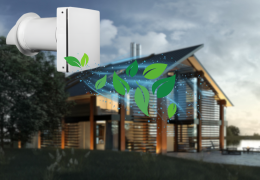Search in blog
Blog categories
Featured posts















Thermostats are devices that play a key role in managing temperature in homes, offices, and industrial buildings. They allow for efficient control of heating and cooling systems, which not only increases comfort but also helps save energy. Modern temperature regulators offer advanced features such as remote control via smartphones, automatic temperature adjustment to user preferences, and integration with smart home systems.
Thermostats are devices that automatically regulate temperature by turning the heating or cooling system on or off to maintain the set temperature level. They work by using a built-in temperature sensor that constantly measures the surrounding temperature. When the temperature drops below the set value, the device activates the heating system, and when the temperature exceeds the set threshold, it turns off the heating or activates the cooling system.
Modern thermostats, especially smart ones, come with additional features such as remote control via an app, the ability to learn user preferences, and scheduling options that automatically adjust to the daily routine of household members. This helps not only maintain a comfortable temperature but also minimize energy consumption, which results in lower bills and benefits for the environment.
Various types of thermostats are available on the market, differing in their functionality, features, and adaptability to user needs. Choosing the right thermostat depends on preferences and the type of heating or cooling system. Here are the main types of temperature regulators:
These allow you to set a temperature schedule, adjusting to the daily routines of the household. They can be programmed to turn on heating before returning home or lower the temperature at night. Some models offer different settings for weekdays and weekends, allowing for better energy management. This helps reduce heating costs and ensures greater convenience.
Electronic thermostats operate precisely with digital temperature sensors, allowing for accurate temperature setting and more energy-efficient operation. Many are equipped with an LCD screen and additional features such as remote control via an app. Manual thermostats are simpler to use and do not require power, as temperature regulation is done manually using a knob or lever. While less precise, they are suitable for places where variable temperature adjustment is not needed.
Binary thermostats are the simplest type, working on an "on-off" principle — they open or close the electrical circuit once the set temperature is reached. These are mainly used in older heating installations such as electric heaters, storage heaters, or boilers, where rapid temperature response is required without the need for adjusting the device’s power. Loadable thermostats are designed to work with larger electrical loads, allowing for control of more advanced heating devices such as heat pumps, gas or oil boilers, and central underfloor heating systems. They provide better control over high-power systems, enhancing their versatility and efficiency in temperature management throughout the building.
These traditional thermostats do not contain electronics and work on the principle of thermal expansion of materials. Temperature change causes physical deformation of an element, such as a bimetallic strip, which activates the electrical circuit. They are simple and durable, commonly used in older heating systems and household appliances like ovens or heaters.
These are advanced electronic devices that can be connected to the internet and controlled via a smartphone, tablet, or computer. With features like automatic learning of user schedules, geolocation, or integration with voice assistants (e.g., Alexa, Google Home), smart thermostats offer high levels of comfort, full control over temperature, and energy savings. They are mainly used in modern smart home systems.
These use a capillary liquid in tubes that reacts to temperature changes, activating or deactivating the electrical circuit. Capillary thermostats are shock-resistant and most often used in household appliances like refrigerators and freezers, where precise temperature control is required.
These adjust the interior temperature of a building based on outdoor weather conditions. They are equipped with an external sensor that measures the air temperature and adjusts the heating system accordingly. This ensures more efficient heating and comfort under changing weather conditions. They are primarily used in advanced heating systems.
These allow for temperature regulation in specific rooms or zones of a building. This way, different temperatures can be maintained in different parts of the house or office, providing more flexible and energy-efficient heating. They are mainly used in underfloor heating systems and installations with heat pumps.
Each type of thermostat has its specific applications and works best in different types of heating or cooling systems. The choice depends on the user’s needs, the system's characteristics, and the technological sophistication required.
Before selecting a device, consider what you need it for and which features are most important to you. Should it be located next to the heating device or in a specific room? Does it need to connect to an app on your phone, or should it be controlled manually? Would you like it to adapt to your daily rhythm, or do you just need to turn it on and off? Answer these questions and find the thermostat that best suits your needs!
Thermostats are key devices that enable precise temperature control, increasing comfort and energy efficiency. There are various types available on the market — from simple manual models to advanced smart ones that can be remotely controlled and adjusted to users’ daily needs. The choice of the right temperature regulator depends on the type of heating or cooling system and user preferences regarding functionality and convenience.

 Jak dbać o bezpieczeństwo swojego domu?
Jak dbać o bezpieczeństwo swojego domu?
 Jak nie spuścić oka ze swojego dziecka?
Jak nie spuścić oka ze swojego dziecka?
 Co zrobić ze zwierzakiem domowym w wakacje?
Co zrobić ze zwierzakiem domowym w wakacje?
 How to create your dream garden?
How to create your dream garden?
 OGRZEWANIE PODCZERWIENIĄ — czym jest i czy warto kupić promienniki?
OGRZEWANIE PODCZERWIENIĄ — czym jest i czy warto kupić promienniki?


Leave a comment